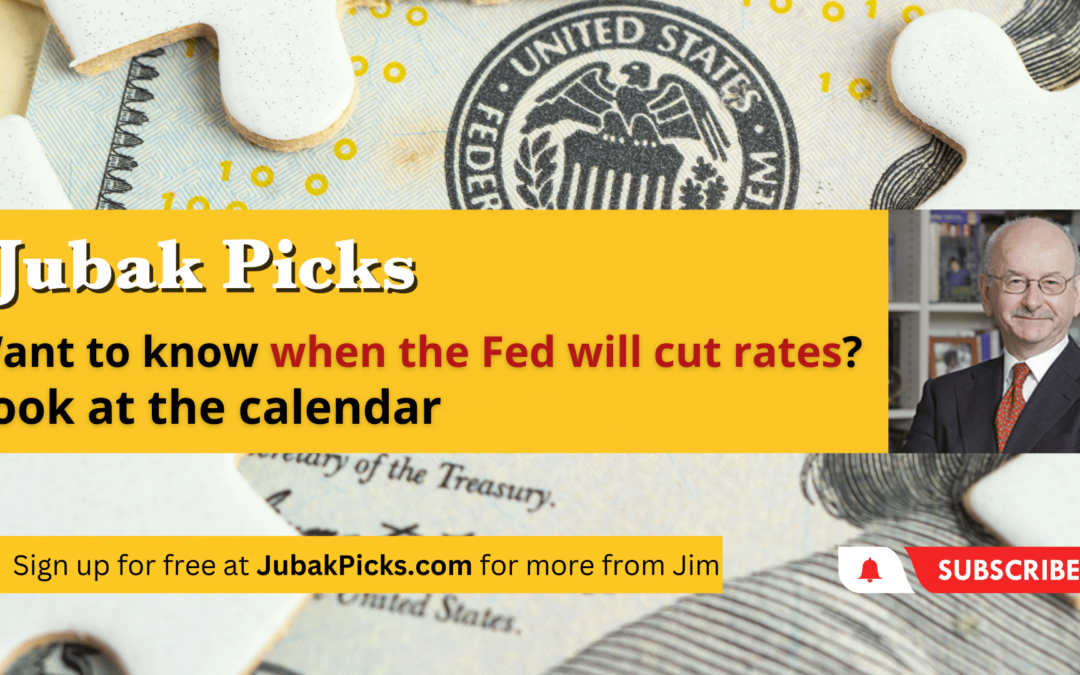Videos

May 15, 2024 | Daily JAM, Perfect Five-ETFs, Videos |
Today’s Hot Button Moves NOW video is Buy Equal Weight S&P Indexes. If you’re concerned about volatility in the tech sector but want to stay in the market, equal weight S&P indexes may be a good alternative. Stocks like Nvidia with a market cap of around 2 trillion, have a lot more weight in the common version of the market cap weighted S&P 500 index than a stock with a smaller cap. In the last week or so, we’ve seen equal weight indexes converge with the longer-term out-performance of the weighted indexes. Using an equal weight index lowers your exposure to the big, now more volatile stocks while keeping you in the market. The Invesco S&P 500 Equal Weight ETF (RSP) is a low expense ratio ETF (.2%) with about $55 billion in assets under management. Year to date, RSP is up 4.68% versus 9.9% year to date for the market cap weighted ETF from Vanguard (VOO). However, for the last 3 months you see a 4.3% return for the equal weight index versus a 4.19% for the market cap weighted index. In the last week, for the first time in a long time, the equal weight index outperformed the weighted index. While one week isn’t a trend, it does seem like the returns are converged. Shifting some S&P exposure from the large cap stocks to this equal weight ETF is a good choice to stay in the game with less volatility. I’m going to make this shift in my Perfect 5 ETF Portfolio on my subscription JubakAM.com site tomorrow May 16.

May 10, 2024 | Daily JAM, Videos |
Today’s video is How big a danger is consumer debt? The Federal Reserve has been slowly trying to get inflation down one more percentage point by slowing the economy (without crashing it). One of the things the Fed looks at is how consumers are doing. Consumer revenue is about 70% of the overall economy and consewuently the Fed has been keeping an eye on consumer debt. At the moment, debt as we can measure it, is at a high level with credit card delinquencies at 3.5% in December 2023, the highest since the current data series istarted in 2012. But that number doesn’t capture everything gong on with consumer debt since the increasingly popular Buy Now, Pay Later products aren’t included in the big consumer debt measurements. Thes products let people stretch or delay payments by cutting them into installlments. The Buy now/pay later market is currently only about $18 billion but is projected to hit $700 billion by 2029. What’s th deliquency ratw for Buy now/pay later? No one knows because the companies providing Buy Now, Pay Later programs don’t report delinquencies to credit bureaus. Anecdotally, the delinquwncy rate seems high. A Bloomberg survey found that about 43% of people in Buy Now, Pay Later programs say they’re behind or feeling pressure on their payments. 28% say they’re delinquent on other debt as a result of these payments. Th Fed faces a tough enough job of sailing the economy to a safe harbor without having to steer blind n a big and growing part of the markrt for consumer debt. My worry is that the economy may be slowing faster than the Fed would hope or can accurately measure. Keep an eye on this as the Fed continues to push rate cuts further and further down the road.

May 8, 2024 | AMZN, Daily JAM, GOOG, Long Term, MSFT, Top 50 Stocks, Videos |
Today’s Quick Pick is Cloud Service Infrastructure Stocks. Normally I’ll choose a specific individual stock for Quick Picks but in this case, I thought I should highlight the entire sector. It’s impossible to overstate the importance of AI technology’s effect on the economy as a whole but it’s also important to look at the individual companies and sectors that benefit from the demand this technology brings to the market. AI has created a revival of growth in the cloud service infrastructure sector, as demand for more processing on databases to run AI programming continues to increase. The sector has seen a revenue growth of about 21% year over year in the first quarter of 2024. The sector is dominated by three companies with Amazon (AMZN) holding the largest share at 31%, and Microsoft (MSFT) with 24% and Alphabet (Google) (GOOG) with 11.5%. This is a $300 billion market, and those three companies have about 66% of it. Smaller players like Alibaba (BABA) and Oracle (ORCL) have A LOT smaller shares at 4% and 3%. However, even that 3% of the market puts Oracle’s cloud revenue at $5.1 billion in the most recent quarter. Revenue in this sector is likely to continue to grow and it looks like good news for all of these companies that set the tone for the market. This is yet another way to get in on the AI boom.

May 6, 2024 | Daily JAM, Videos |
Today’s Hot Button Moves NOW video is Tech Worries. In my last video, I suggested the normal advice of “go away in May” may be valid again this year because of the revenue patterns I’m seeing in the technology sector, especially tech/consumer stocks, like Apple (AAPL). On May 2nd, Apple beat $1.50 expectations by reporting $1.53 a share. Revenue also beat at $90.8 billion (Wall Street expectations had it at $90.3 billion.) iPhone revenue was at $45.96 billion, down from $51.33 billion in 2023. The stock went up by about 6% after the report, even though it was a modest beat of already lowered expectations. Apple also announced an increase to its dividend of $.25 a share and a buyback program of $110 billion. CEO Tim Cook announced plans for the iphone to add AI in the future as Apple catches up with the use of AI at competitors such as Samsung. This promise of a wonderful future, combined with a modest beat, was enough to boost the stock. This is just one more example of a pattern I’m seeing in the sector currently where technology companies make vague, date-less promises of bigger and better things to come, with very little tangible proof or actual products. Investors are being asked to pay as if these are growth stocks, when in fact these promises may never come to fruition. The market is trying to extend a rally but “Go away in May” may be the safer bet.

May 3, 2024 | AAPL, Daily JAM, NVDA, Short Term, Videos |
Today’s video is Go Away in May? Historically, the months between November and May were much more profitable than the months from May to November. The saying “Go away in May” came from that distribution of returns, suggesting investors should get out of the market during the less profitiable May to November period. This advice holds particularly true for tech stocks, which have very clear seasonal revenue patterns. For example, in March of 2023, Apple (AAPL) earned $1.52 per share, in June earnings per share went down to $1.26, in September they went back up to $1.46 and then the company blew it out in December to $2.18. While this isn’t indicative of the entire tech sector, it’s a good example of this seasonal pattern, especially for technology stocks with big consumer businesses. So what about this May? I’d say, you can probably “go away”–but maybe a little late than usual. NVIDIA’s (NVDA) earnings come out on the 22nd of May and will likely be giant. Current Wall Street estimates have earnngs per share at $5.14, up from $.88 a year ago. After that,the technology sector is relatively quiet. The next big tech event to look out for is Apple’s Worldwide Developers Conference in June, which could result in “buzzy” tech announcements about AI. After that, I don’t see a lot of reason to be overweight technology and I’ll look to take some profits. I think this amounts to a modest Go Away in May call.

April 30, 2024 | ALV, Daily JAM, Jubak Picks, Videos |
Today’s Quick Pick is Autoliv Inc (ALV). Autoliv makes auto safety equipment from seatbelts to newer products such as driver assistance and lane keep. They have a 45% global share of the global auto safety market with growing penetration in China. (China is now about 22% of sales). With a 40% market share in China, the company has room to grow, especially as China exports more and more vehicles. As Chinese car exports grow, so too will Autoliv’s sales of safety products. Chinse cars for the domestic market include 2-3 Autoliv products. Cars for the export market include 4-5. Autoliv just announced earnings on April 25 which beat estimates by about 18% with about a 70-80% increase in earnings year over year. Morningstar calls the stock fairly valued, I think that’s an underestimate. The price to sales on the stock is currently at 0.97 and the trailing 12-month PE is 19.17, and the forward EPS is at 13. The shares also offer a 2.1% dividend yield with a buyback yield of 4.7%. Free cash flow is rising (up $170 million last year) even while the company is investing more in China, India, and Vietnam. Autoliv has also shown a solid increase in operating margin in the most recent quarter from 5.17% to 7.4% and management is hoping to drive that up to 10%. I’m adding the shares to my Jubak’s Picks Portfolio.

April 25, 2024 | Daily JAM, Videos |
Today’s video is NOW I’m Worried About Stocks. Investors and analysts have shown a willingness to pay for vapor in the last couple of days. The market reaction to two companies, Tesla (TSLA) and Apple (AAPL), has made this clear me.. Tesla’s earnings were terrible at $0.45 a share, below the expectations of $0.52 and revenue was down 50% year over year. However, the stock was up the day after earnings thanks to expert spin from CEO Elon Musk. He announced that Tesla will move ahead with the Robotaxis and full self-driving cars but it will also advance plans to produce a $25,000 car to enter the lower end of the market and compete with China. Although the company previously waffled on offering a more affordable Tesla, Musk was now suggesting it may be available at the end of 2024 or early 2025. When asked for more specifics, Musk declined to offer a definitive date on any of these promises. Wall Street ate it up and jumped on the spin that Tesla will be selling a more affordable vehicle “soon.” At this point, these are totally imaginary revenues from a car that has no release date and a full self-driving technology that doesn’t fully exist yet, and investors are saying they’re willing to pay for it? What worries me here is that in the market paying for spin has become normal because stocks go up on spin. Even if the product is “vapor,” investors are willing to get in on the stock bump associated with the announcement of imagined prospects. Similarly, Bank of America recently predicted Apple (APPL) is going to go up 36% soon because the company will announce its plans for adding AI into the iPhone. This is speculation on an announcement, not of the product itself, but on the prospect of an announcement. Bank of America is likely right on this, but I’m not willing to pay up for this speculative announcement without a tangible product or date and it concerns me that the market IS willing to do that. I understand the spins and the anticipation but the reaction and willingness to buy on vapors isn’t a sign of a healthy market.

April 22, 2024 | Daily JAM, Videos |
Today’s Quick Pick is Abbott Laboratories (ABT). The medical device sector is very complicated with constant changes to technology and best practice therapeutics and it can be very hard to keep track of, but two things recently caught my eye about Abbott. The company is generally very conservative and rarely raises guidance, but it did exactly that in its first quarter earnings report. It wasn’t a huge raise but the company went from projecting earnings in a range of $3.20 a share to $3.40 a share to a range with a higher floor of $3.25 to $3.40 a share. The other announcement was a big boost in sales of its diabetes continuous glucose monitoring device, Freestyle Libre. Sales grew to $1.5 billion, up 22.4% year over year. Overall, at the company medical device sales grew 14% year over year, though their Covid test sales were down 18% year over year. I think this is a medical device company that is well-positioned for an aging population. The stock pays a 2.08% dividend. Morningstar says this stock trades at fair value with the shares down about 7.8% in the last month. I think this is a good chance to buy this well-managed, conservative company.

April 18, 2024 | ASML, Daily JAM, Long Term, Top 50 Stocks, Videos |
Today’s Hot Button Moves NOW video is Buy ASML Holding (ASML). ASML is the only global manufacturer of the most cutting-edge chip-making equipment, a technology called Extreme Ultra Violet Lithography (EUV). The equipment allows for a smaller chip, more transistors on the chip, and more power for less silicon. ASML’s earnings report on April 16 was disappointing, with fewer than expected orders, a situation that will likely continue into the next couple of quarters. This resulted in a big drop in earnings and the stock taking a big hit. But, this is the only game in town for this equipment, and anything chip that uses the new 2-nanometer, 3-nanometer, and 5-nanometer technologies will be made on ASML equipment. So orders will not stay down for long. I would use this weakness to buy ASML Holding. It’s not cheap, but it’s not likely not get much cheaper than this, and as geopolitical chip wars settle, orders for ASML will jump rebound. ASML Holding is a member of my long-term 50 Stocks Portolio.

April 17, 2024 | Daily JAM, Videos |
Today’s video is Want to know when the Fed will cut rates? Look at the calendar. The Fed only has so many meetings left for 2024 and even fewer if you only coun those with Dot Plot updates of the Fed’s economic projections. The Fed is on the verge of a major shift in policy and the U.S. central bank almost never makes a big policty shift at a meeting without an update of its economic projections.. Early in the year, people were looking for up to five cuts, now, sentiment has shifted to one or fewer. If we get a rate cut at all, when will it be? Look at which upcoming Fed meetings include Dot Plots. The Fed doesn’t like to surprise investors and if they make a drastic change, like a shift to rate cuts, you can bet they want to do it while they’re also discussing projections for 2024 and 2025. The.CME Fedwatch Tool currently odds for the next meeting, May 1, at a 98% chance of no cut and the June meeting is now up to an 84.8% chance of no cut. The June meeting WILL have a Dot Plot and, up until recently, the finanial markets believed that meeting that would deliver the news. Because the Fed generally likes to give in-depth information during a big policy shift, it’s unlikely that the rate cut will be in July, since no dot Plot economic pdate is scheduled for that meeting. The next real chance of a rate cut, I think, is September 18, which has a Dot Plot. (There is no August Fed meeting.) The market thinks there will be a cut in September, and CME Fedwatch has the odds of no cut at that meeting at just 32.7%. A second rate cut in 2024 would have to be at the December 18 meeting, the final 2024 meeting with a Dot Plot. (The Fed doesn’t meet in Ocrober and the November meeting does include a Dot Plot update.) Without the September cut, it’s very unlikely there will be two cuts in 2024. Unless inflation data changes a lot, I doubt we’ll have two rate cuts, but we can look for one in September or December at this point.

April 1, 2024 | Daily JAM, Jubak Picks, MRNA, Videos |
To subscribe to JAM you need to fill in some details below including, ahem, some info on how you'll pay us. A subscription is $199 (although if you're subscribing with one of our special offers it will be lower) for a year for ongoing and continuing access to the...

March 29, 2024 | Daily JAM, Videos |
Today’s video is Tech CEOs Calling a Top in This Market? The Financial Times just did a story about tech CEOs insider buying and selling. During the first quarter of 2024, the ratio of insider selling vs. insider buying has climbed to heights not seen since the first quarter of 2021. Amazon’s CEO Jeff Bezos, sold about $135 million of Amazon stock and Peter Thiel, cofounder of Palantir Technologies, sold $175 million worth of stock in March. Why? There could be a few reasons for these sales. During the rally at the end of 2023, many investors put off selling until 2024 to delay capital gains taxes and we’re seeing that selling demand now. Additionally, these tech CEOs have tremendous amounts of their wealth tied up in one asset, and in order to diversify, they must sell some of those shares. But CEOs could be selling because they feel this market is near a top. The fear that we’re in a bubble like that in the dot com era has been nagging investors and these sales by tech CEOs are contributing to that fear. I think we’re likely to be still a year or more away from a top in this rally. I don’t expect to start to hear a negative narrative about AI until 2025 or 2026. New technology takes a while to work through the system and I think around 2025-2026 companies will notice that their new AI technologies haven’t yet produced the returns they hoped on the schedule they imagined and the market will start to react. That will be the time for a sell off. And for long term investors to buy on any excessive selling, (Remember how long it took before the massive investment in PCs started to drop to bottom lines.) In the meantime, I don’t see a bubble popping in 2024 and while this news from tech CEOs doesn’t make me feel better, I do think it’s important to recognize that tech CEOs have reasons to sell now that don’t have much of anything do with your portfolio’s risk portfolio.















